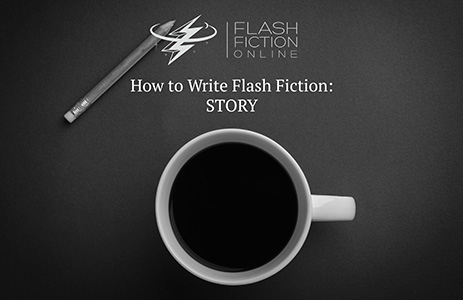
 Let’s start learning how to write teeny-tiny snippets of fiction by looking at it’s polar-opposite–the cinematic epic form of story you’ve learned to love, the movies.
Let’s start learning how to write teeny-tiny snippets of fiction by looking at it’s polar-opposite–the cinematic epic form of story you’ve learned to love, the movies.

by Robert McKee.
I know, I know. You’re a FLASH FICTION WRITER. Why do I want you to read a book about SCREENWRITING?
Robert McKee lays down the fundamental doctrines of how to tell a classical narrative. His theory is that before you can write a multi-protagonist, second-person point-of-view, inanimate object narrator, anti-hero saga, you must first master the classical narrative.
It’s not even about learning the rules. It’s identifying the structure of storytelling that has worked from Plato to Dante to modern day.
McKee even notes that the shaky beginner clings to rules. The rebellious writer breaks the rules. But it’s the artist who uses the full set of tools at his disposal to create a masterwork.
With this in mind, we’re going to breakdown the framework of story over the next few weeks. We’ll look at structure and how it effects plot. It’s a lot to take in, which is why I highly suggest you read McKee’s book. Keep it on your bookshelf, pull it down, go through it every now and again. Your writing will be stronger because of it.
I would like to say we live in a time of great storytelling. But we don’t.
We are the product of YouTube, Vimeo, Flickr, and Vine. Our lives are snippet-sized sound bites ready not for the evening news like our parents’ generation, but for a Facebook video we hope goes viral. Storytelling has been reduced to the shock value of an image, a gasp, a shove into a million others just like it.
Where is the craft? Yes, you can argue there is a psychology of marketing behind those soundbites and snippets but how much more is there in concocting an entire world with the enough impact to bring readers to collective tears of sorrow or wonder?
And I’m not talking about literary finesse either. That’s an entirely different skill than storywriting.
Let me put it this way.
Krispy Kreme donuts are one of my favorite things (Don’t judge. I’m Southern. Very.) Now, you could fancy one up, glaze it with some foofy sauce or another, and call it a cream puff or eclair or jumbo petit four, but at the end of the day, it’s still going to have the nutritional density of a…yeah…Krispy Kreme donut.
Story is like that too (only far less hydrogenated).
You can labor for hours and hours. Months. Years. A lifetime. Making each phrase melodic and rhythmic.
But at the end of the day, if the story sucks, it’s still a Krispy Kreme donut.
(This analogy is failing because I would eat that donut but I wouldn’t buy your story.)
You get my gist.
Story is more than plot.
What is plot? Well, we’ll get to that in more details so hold your horses, but for now, let’s say plot is the writer’s way of moving characters through events in time.
Story is the whole kit and caboodle
Plot + Characters + Setting + Struggle + Twists/Turns/Reversals + Final Confrontation + Denouément
Now, not every story is going to follow a classical narrative (which is what I gave you).
But a classical narrative (McKee calls this an “archplot) has a few defining features:
- Causality
- An active protagonist
- Closed ending
- Linear time
- External conflict
- Consistent reality
In movie terms, since we’re talking Hollywood, think about your favorite movie plots. Do they fit this structure? For example, take The Wizard of Oz.
Dorothy is our active protagonist. A tornado blows her to Oz (causality). The time runs in a linear fashion. She makes her way through Oz, and even though it’s Oz, it’s a consistent reality that we can believe. Dorothy doesn’t have an internal crisis about her place in the universe. Her main conflict is external–getting home. And the film ends with Dorothy returned to Kansas for a tidy closed ending.
Could it have been more literary? Of course. Experimental? Of course.
But from a storytelling perspective, The Wizard of Oz captured fans across the world with its straightforward yet dynamic story.
The system works. And we, as writers, can use this to our advantage. There’s no need to recreate the wheel when sometimes all we need to do is roll.
So here’s your challenge for today:
Pick three of your favorite famous Hollywood movies. Break them down and see if they fit the classical narrative structure.
THEN…come up with a story outline (the length doesn’t matter) that meets the same criteria. If you feel inspired to write the whole thing, then by all means, do it. You know where to find our submissions link.
Post your outline in the comment section below and your fellow writers will leave feedback (CONSTRUCTIVE ONLY).
Now, off to it. And happy writing!